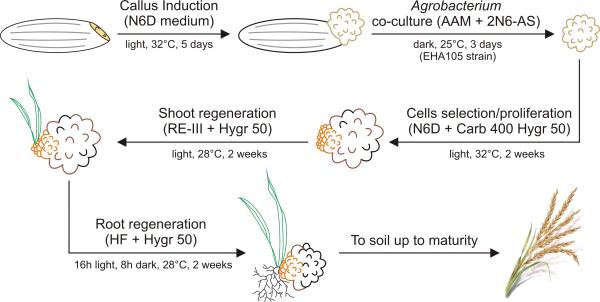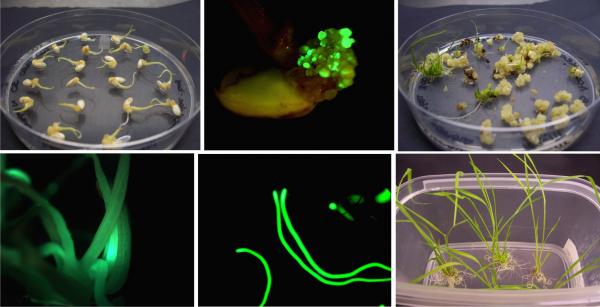Agrobacterium-mediated transformation of rice
added by Leonardo Magneschi* and Steven Favali. From: Toki et al., The Plant Journal (2006) 47, 969–976
The Protocol takes roughly two months from the induction of the scutellum-derived callus to the regeneration of rooted plantlets that can be transferred to soil. First, the formation of scutellar calli is induced in a media containing the synthetic auxin 2,4-D. Calli are then co-cultured with Agrobacterium tumefaciens for three days under dark conditions in the presence of acetosyringone. Bacteria are then removed from co-cultured calli by means of carbenicillin and put on N6D supplemented with hygromycin to promote the proliferation of transformed cells. After about two weeks of proliferation, calli are ready for shoot regeneration on RE-III. This is a critical step that can take two-four weeks depending on lab conditions. Thereafter, root induction is carried out on HF medium for two more weeks. Plantlets are then ready for transfer to soil or hydroponic solution and can be grown for the production of seeds.
For specific information about the composition of the media, please refer to the original article by Toki et al. (2006).
Here is a scheme of the step involved:

Below some pictures related to the generation of transgenic rice plants are reported. Left to right: induction of scutellum-derived calli on N6D medium; proliferating transformed calli expressing GFP; transformed calli during differentiation of shoots on RE-III medium; regenerating shoots and roots expressing GFP under the control of the 35S (CaMV) promoter; 2-week-old regenerated plantlets ready for acclimation.
